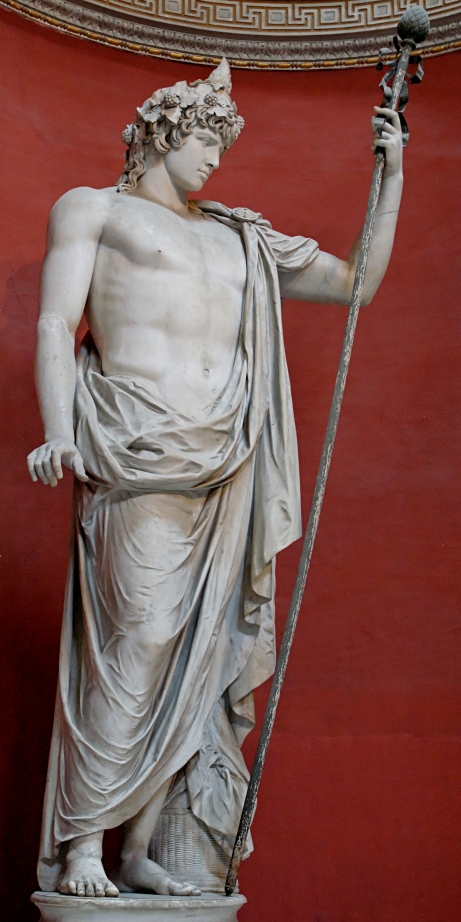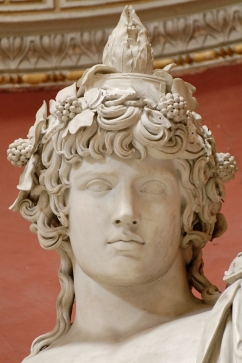
The photo above shows the statue known as the Braschi Antinous, on display in the Musei Vaticani.1 The museum catalog gives the identification in this way:
In this statue, which dates from the years immediately following his death, Antinous is shown in a syncretic Dionysus-Osiris pose. On his head is a crown of leaves and ivy berries, and a diadem which at the top would originally have held a cobra (uraeus) or a lotus flower, but which the modern restorers have replaced with a sort of pine cone. The Dionysian attributes of the thyrsus and the mystical chest are also modern additions.2
Antinous himself is a figure shrouded in mystery and palace intrigue. We know from literary sources that he was a young man from Bithynia who had attracted the amorous attentions of the emperor Hadrian. Cassius Dio describes Antinous as a “παιδικὰ” (a “boy-toy”) of Hadrian, suggesting that in taking the lover, the emperor was trying to imitate models of traditional Greek pederasty.3 Antinous followed Hadrian on his tours of the provinces and died in Egypt. His death was the subject of controversy and the source of his lasting fame. There was a rumor that Antinous had been offered as a human sacrifice for the health of his lover and emperor. Cassius Dio gives us a succinct summary of the opposing stories of Antinous’s death:
ἐν τῇ Αἰγύπτῳ ἐτελεύτησεν, εἴτ᾽ οὖν ἐς τὸν Νεῖλον ἐκπεσών, ὡς Ἁδριανὸς γράφει, εἴτε καὶ ἱερουργηθείς, ὡς ἡ ἀλήθεια ἔχει.4
Aurelius Victor elaborates further:
Hadriano cupiente fatum producere, cum voluntarium ad vicem magi poposcissent, cunctis retractantibus Antinoum obiecisse se referunt, hincque in eum officia supra dicta.5
Indeed, perhaps the only thing we know for certain about Antinous is that after his death the emperor had him deified and countless statues of him set up all over the empire. Pausanias describes the honors offorded to Antinous in the town of Mantineia:
ἐνομίσθη δὲ καὶ Ἀντίνους σφίσιν εἶναι θεός: τῶν δὲ ἐν Μαντινείᾳ νεώτατός ἐστιν ὁ τοῦ Ἀντίνου ναός. οὗτος ἐσπουδάσθη περισσῶς δή τι ὑπὸ βασιλέως Ἀδριανοῦ: ἐγὼ δὲ μετ᾽ ἀνθρώπων μὲν ἔτι αὐτὸν ὄντα οὐκ εἶδον, ἐν δὲ ἀγάλμασιν εἶδον καὶ ἐν γραφαῖς. ἔχει μὲν δὴ γέρα καὶ ἑτέρωθι, καὶ ἐπὶ τῷ Νείλῳ πόλις Αἰγυπτίων ἐστὶν ἐπώνυμος Ἀντίνου…ὁ βασιλεὺς κατεστήσατο αὐτῷ καὶ ἐν Μαντινείᾳ τιμάς, καὶ τελετή τε κατὰ ἔτος ἕκαστον καὶ ἀγών ἐστιν αὐτῷ διὰ ἔτους πέμπτου. οἶκος δέ ἐστιν ἐν τῷ γυμνασίῳ Μαντινεῦσιν ἀγάλματα ἔχων Ἀντίνου καὶ ἐς τἄλλα θέας ἄξιος λίθων ἕνεκα οἷς κεκόσμηται καὶ ἀπιδόντι ἐς τὰς γραφάς: αἱ δὲ Ἀντίνου εἰσὶν αἱ πολλαί6
Antinous’ lasting legacy lies in the statues of him like the ones Pausanias saw in Mantineia, many of which have been recovered in excavations all around the Mediterranean, including many from several of Hadrian’s villas around Rome. The statue above in the Vatican, which was excavated in Hadrian’s villa in Praeneste, is one of these, but the Vatican collection also includes several other sculptures of Antinous from the areas around Rome.
What, however, makes this sculpture a statue of Antinous? The most characteristic feature of Antinous is his long, curly hair. Antinous has thick, beautifully unkempt locks which cascade down the back of his neck in layers. Yet just because a statue has curly hair doesn’t mean that it is Antinous; it could be, for example, a generic beautiful youth. Modern scholars have attempted analyze the exact way in which the locks flow down a sculpture’s neck in order to more accurately identify Antinous, but this so-called “lock scheme” for classification has run into problems.7 The second identifying feature of an Antinous is his distantly melancholy downward looking expression, what Caroline Vout calls the “fleshy pout and down-turned head” that gives Antinous an “overall sensuous but sulky air.”8

Our sculpture in the Vatican clearly has Antinous’s hot and rugged curls and his sexy sulk. Throw in its Praeneste provenance, and the identification would seem to be assured. Yet again, nothing about Antinous’s characteristics are unique to Antinous. He has no attributes, like Herakle’s’ lion skin or Dionysus’s garlands and thyrsis. Antinous’s image is nothing more than a particular version of the generic pretty-boy genre. Especially when Antinous is syncretized with another god or gods, as he is with Dionysus and Osiris here, it becomes increasingly difficult to make a certain identification. The only sure Antinouses are those found with an inscription of his name (as for example the obelisk dedicated to Antinous now on display in the Villa Borghese park).
But that’s exactly the point. Nearly all ancient portraits are syncretizations and combinations of some sort. Sculptures of Augustus are clearly modeled after Alexander the Great. Alexander’s statues are themselves modeled after Apollo, who in turn has his roots in the Egyptianizing kouros sculptures of early Greece. Ancient portraits aren’t so much attempting to render a faithful likeness of their subject, but rather to make statements by drawing on a shared sculptural vocabulary. By using subtle combinations of features from earlier sculpture types, portraits can draw parallels equating their subjects with gods and great men of the past. Augustus is Alexander. Alexander is Apollo. If the viewer of our Antinous sculpture were confused at first by the lack of attributes into thinking it was a sculpture of Dionysus, or of Osiris, or any number of other pretty-boy gods, Hadrian would be pleased.


